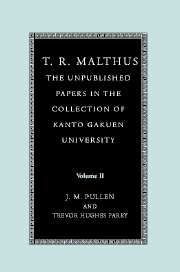Book contents
- Frontmatter
- Contents
- Preface
- Editorial procedures
- List of abbreviations
- Acknowledgements
- 1 Sermons
- 2 Malthus' diary of a tour of the Lake District
- 3 Bullion trade transactions
- 4 An essay on foreign trade
- 5 Essays and notes on Charles I and Mary, Queen of Scots
- 6 Questions and answers on early European history
- 7 Harriet Malthus' diary of a family tour of Scotland in 1826
- 8 Letters to Harriet Malthus from her mother, Catherine Eckersall
- 9 Eight brief miscellaneous items
- Appendix A Additional material not reproduced
- Appendix B Letters to David Ricardo
- Bibliography
- Kanto Gakuen Catalogue
- Index
8 - Letters to Harriet Malthus from her mother, Catherine Eckersall
Published online by Cambridge University Press: 23 December 2009
- Frontmatter
- Contents
- Preface
- Editorial procedures
- List of abbreviations
- Acknowledgements
- 1 Sermons
- 2 Malthus' diary of a tour of the Lake District
- 3 Bullion trade transactions
- 4 An essay on foreign trade
- 5 Essays and notes on Charles I and Mary, Queen of Scots
- 6 Questions and answers on early European history
- 7 Harriet Malthus' diary of a family tour of Scotland in 1826
- 8 Letters to Harriet Malthus from her mother, Catherine Eckersall
- 9 Eight brief miscellaneous items
- Appendix A Additional material not reproduced
- Appendix B Letters to David Ricardo
- Bibliography
- Kanto Gakuen Catalogue
- Index
Summary
INTRODUCTION
The five long letters in this chapter are from Catherine Eckersall to her eldest daughter, Harriet Malthus, wife of Malthus. Catherine Eckersall wrote the letters while on a two-month holiday to the Lake District in the summer of 1825 with a large family party. As the first letter indicates, Malthus and his wife and their two surviving children (Emily and Henry) were then about to return from a holiday in Europe, following the death of their third child, Lucy, on 3 May 1825, aged 17. The letters refer to specific days and months, but not the year. However, the year (1825) is evident from the (indirect) references to the death of Lucy.
Although the letters contribute only slightly to our knowledge of Malthus himself, they are a valuable source of information about the characters and activities of his relatives, and provide an interesting insight into the lives and attitudes of an upper-middle-class English family in the 1820s.
Catherine Eckersall (1755–1837), née Wathen, was a first cousin of Malthus – a daughter of a sister of Malthus' father. She was said to be very handsome and was painted by Sir Joshua Reynolds. In 1774 she married John Eckersall (1748-1837), who was a first cousin to her (son of a sister of her mother). As Catherine Eckersall's mother and John Eckersall's mother were sisters of Malthus' father, they were both first cousins to Malthus.
- Type
- Chapter
- Information
- Publisher: Cambridge University PressPrint publication year: 2004



